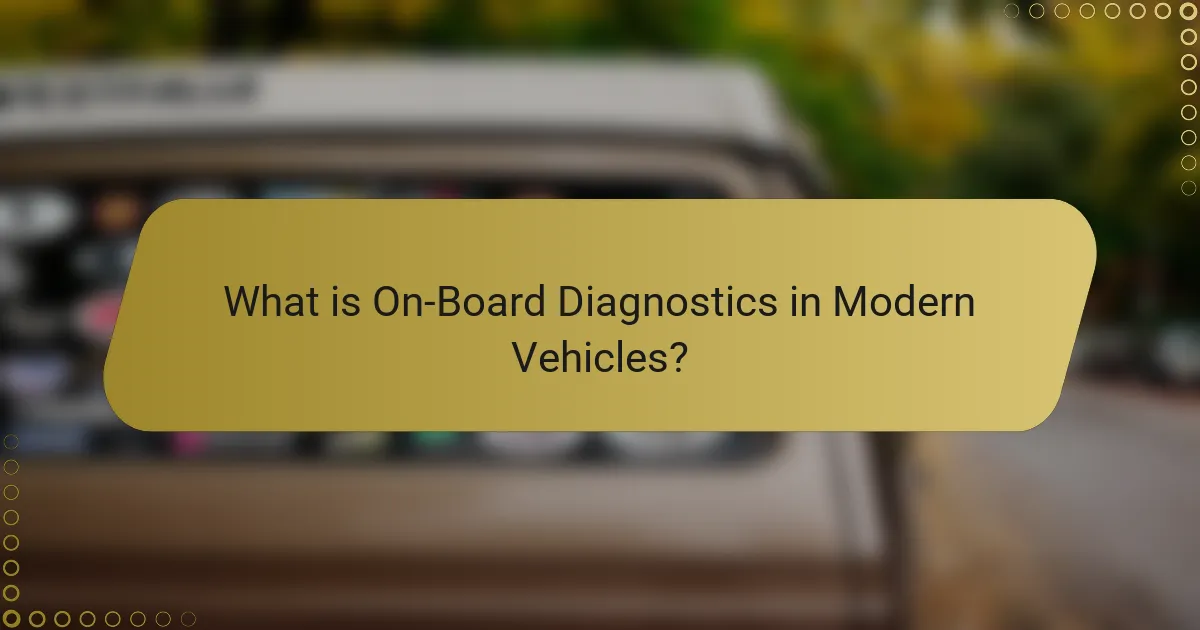On-Board Diagnostics (OBD) is a critical system in modern vehicles that monitors performance and emissions, providing real-time data on engine and essential systems. The evolution from OBD-I to OBD-II has standardized diagnostic protocols, allowing for comprehensive vehicle diagnostics and efficient communication with diagnostic tools. OBD systems detect malfunctions, store diagnostic trouble codes (DTCs), and facilitate vehicle maintenance by alerting drivers to service needs. Additionally, modern OBD systems support advanced features such as remote diagnostics, predictive maintenance, and integration with mobile applications, enhancing vehicle management and compliance with environmental regulations. The article explores the significant role of OBD in vehicle performance monitoring, maintenance, and the implications for fleet management and aftermarket enhancements.

What is On-Board Diagnostics in Modern Vehicles?
On-Board Diagnostics (OBD) in modern vehicles is a system that monitors vehicle performance and emissions. It provides real-time data on the vehicle’s engine and other essential systems. OBD systems can detect malfunctions and store diagnostic trouble codes (DTCs). These codes help technicians identify issues during vehicle servicing. OBD has evolved through several iterations, with OBD-II being the most widely used standard since the 1990s. OBD-II enables standardized communication between the vehicle and diagnostic tools. This standardization improves repair efficiency and accuracy. Modern vehicles often feature advanced OBD systems that can interface with mobile apps for user-friendly diagnostics.
How does On-Board Diagnostics function in vehicles?
On-Board Diagnostics (OBD) functions by monitoring vehicle performance and emissions. It uses a network of sensors and control modules to collect data from various systems. The OBD system checks for malfunctions and ensures compliance with emission standards. When a fault occurs, it triggers a diagnostic trouble code (DTC). This code helps technicians identify issues during vehicle diagnostics. OBD systems provide real-time data on engine conditions, fuel efficiency, and more. The information is accessible through an OBD-II port using a scan tool. This functionality enhances vehicle maintenance and reduces emissions, ensuring better environmental compliance.
What are the key components of On-Board Diagnostics systems?
The key components of On-Board Diagnostics (OBD) systems include the OBD control unit, sensors, actuators, and diagnostic connectors. The OBD control unit processes data from various vehicle systems. Sensors monitor parameters like engine temperature, air-fuel ratio, and exhaust emissions. Actuators control components such as fuel injectors and ignition timing based on sensor data. Diagnostic connectors provide access for external diagnostic tools. Together, these components enable real-time monitoring and diagnostics of vehicle performance and emissions. This integration is essential for compliance with environmental regulations and vehicle maintenance.
How do these components interact to monitor vehicle performance?
On-board diagnostics (OBD) components interact through a network of sensors, control units, and software algorithms to monitor vehicle performance. Sensors collect data on various parameters such as engine temperature, speed, and emissions. This data is transmitted to the vehicle’s Engine Control Unit (ECU) for analysis. The ECU processes the information to assess performance metrics and detect any anomalies. If a fault is identified, the ECU triggers diagnostic trouble codes (DTCs). These codes help technicians pinpoint issues during vehicle maintenance. The interaction of these components ensures timely performance monitoring and compliance with emissions regulations.
What are the primary purposes of On-Board Diagnostics?
The primary purposes of On-Board Diagnostics (OBD) are to monitor vehicle performance and diagnose issues. OBD systems collect data from various sensors in the vehicle. They help identify malfunctions in the engine and emissions control systems. This technology enables real-time monitoring of vehicle health. OBD can also provide diagnostic trouble codes (DTCs) for repair technicians. These codes indicate specific issues that need attention. Additionally, OBD assists in ensuring compliance with environmental regulations. It plays a critical role in reducing vehicle emissions.
How does On-Board Diagnostics help in vehicle maintenance?
On-Board Diagnostics (OBD) helps in vehicle maintenance by providing real-time data about the vehicle’s performance. OBD systems monitor various components, including the engine, transmission, and exhaust systems. They detect malfunctions and store diagnostic trouble codes (DTCs). Mechanics can access these codes to identify issues quickly. This reduces diagnostic time and improves repair accuracy. Additionally, OBD systems can monitor emissions, ensuring compliance with environmental regulations. Regular OBD checks can help maintain optimal vehicle performance and fuel efficiency. According to the Environmental Protection Agency, OBD systems have significantly reduced vehicle emissions since their implementation.
What role does On-Board Diagnostics play in emissions control?
On-Board Diagnostics (OBD) plays a critical role in emissions control by monitoring vehicle performance and emissions-related systems. OBD systems detect malfunctions that could lead to increased emissions. They provide real-time data on engine performance, fuel efficiency, and exhaust emissions. When a fault occurs, OBD triggers a warning light on the dashboard. This prompts drivers to address issues that could harm the environment. According to the U.S. Environmental Protection Agency, OBD systems have significantly reduced harmful emissions since their implementation in the 1980s. They help ensure vehicles comply with emissions standards set by regulatory bodies.

How has On-Board Diagnostics evolved over time?
On-Board Diagnostics (OBD) has evolved significantly since its inception in the 1980s. Initially, OBD-I systems provided basic diagnostic capabilities, mainly for emissions control. These systems used a limited set of trouble codes and were not standardized across manufacturers. The introduction of OBD-II in the mid-1990s marked a major advancement. OBD-II standardized diagnostic protocols and expanded the number of monitored parameters. This allowed for more comprehensive vehicle diagnostics and improved communication between the vehicle and diagnostic tools. The implementation of OBD-II was mandated by the U.S. government in 1996 for all new vehicles. Since then, advancements have continued with the integration of real-time data monitoring and telematics. Modern OBD systems now support advanced features like remote diagnostics and predictive maintenance. This evolution reflects the automotive industry’s shift towards more connected and efficient vehicle technologies.
What advancements have been made in On-Board Diagnostics technology?
Recent advancements in On-Board Diagnostics (OBD) technology include the transition from OBD-I to OBD-II systems. OBD-II systems provide standardized diagnostic trouble codes (DTCs) across all manufacturers. They enable real-time monitoring of vehicle performance and emissions. Enhanced data logging capabilities allow for better analysis of vehicle health. Wireless communication technologies like Bluetooth and Wi-Fi have been integrated for easier access to diagnostic data. Advanced algorithms improve fault detection accuracy and reduce false positives. Additionally, the development of mobile applications facilitates user-friendly access to diagnostics. These advancements enhance vehicle maintenance and compliance with environmental regulations.
How have regulations influenced the development of On-Board Diagnostics?
Regulations have significantly influenced the development of On-Board Diagnostics (OBD) systems. The introduction of the OBD-I standard in the 1980s was a response to the need for improved vehicle emissions control. This regulation mandated that vehicles be equipped with diagnostic capabilities to monitor emissions-related components.
In the 1990s, the OBD-II standard further advanced these requirements. It established a uniform diagnostic interface across all vehicles sold in the United States. This standardization allowed for better compatibility with diagnostic tools and improved the accuracy of emissions monitoring.
Regulatory bodies, such as the Environmental Protection Agency (EPA), have continuously updated these standards to address emerging environmental concerns. For example, regulations have pushed for the inclusion of additional sensors and monitoring capabilities to track fuel efficiency and overall vehicle performance.
These regulations have led to the integration of advanced technologies, such as real-time data reporting and onboard troubleshooting. As a result, modern OBD systems are now essential for vehicle maintenance and compliance with environmental laws.
Overall, regulations have shaped OBD development by enforcing standards that enhance vehicle diagnostics, emissions control, and overall performance monitoring.
What are the differences between OBD-I and OBD-II systems?
OBD-I and OBD-II are two generations of On-Board Diagnostics systems in vehicles. OBD-I was introduced in the 1980s and is specific to manufacturers, lacking standardization. OBD-II, implemented in the mid-1990s, is standardized across all manufacturers, allowing for universal diagnostic tools.
OBD-I systems typically provide limited diagnostic capabilities and focus mainly on emissions-related issues. In contrast, OBD-II systems offer comprehensive diagnostics, including real-time data and enhanced monitoring of vehicle performance.
OBD-I uses a 12-pin connector, while OBD-II standardized connectors to 16 pins. OBD-II also supports a wider range of diagnostic trouble codes (DTCs) and provides access to more vehicle parameters.
As a result, OBD-II systems allow for more detailed troubleshooting and better compliance with environmental regulations.
How does On-Board Diagnostics improve vehicle safety?
On-Board Diagnostics (OBD) improves vehicle safety by monitoring vehicle performance and identifying malfunctions. OBD systems continuously check critical components like the engine, brakes, and emissions systems. When a fault is detected, the system triggers warning lights on the dashboard. This alerts drivers to potential issues before they lead to accidents. For example, faulty brakes or engine problems can be identified early through OBD. Studies show that regular OBD checks can reduce the likelihood of breakdowns by up to 30%. By ensuring that vehicles are operating correctly, OBD contributes significantly to overall road safety.
What safety features are monitored by On-Board Diagnostics?
On-Board Diagnostics (OBD) monitors several safety features in vehicles. These include the Anti-lock Braking System (ABS), airbag system, and traction control. OBD tracks the performance and functionality of these systems. It ensures that they operate correctly to enhance vehicle safety. If a malfunction occurs, OBD triggers a warning light on the dashboard. This alerts the driver to potential safety issues. The monitoring helps maintain compliance with safety regulations. OBD systems are essential for diagnosing and resolving safety-related problems in modern vehicles.
How can On-Board Diagnostics assist in diagnosing safety-related issues?
On-Board Diagnostics (OBD) assist in diagnosing safety-related issues by monitoring vehicle systems for malfunctions. OBD systems track critical components such as brakes, airbags, and stability control. They generate diagnostic trouble codes (DTCs) when a safety-related issue is detected. This allows technicians to identify specific problems quickly. For example, a malfunctioning airbag sensor will trigger a DTC. The OBD system also provides real-time data, which aids in assessing vehicle performance. According to the National Highway Traffic Safety Administration, OBD systems have improved vehicle safety by enabling timely repairs. This demonstrates the effectiveness of OBD in enhancing overall vehicle safety.

What are the practical applications of On-Board Diagnostics?
On-Board Diagnostics (OBD) is a system used in vehicles to monitor performance and diagnose issues. Its practical applications include vehicle emissions monitoring, which ensures compliance with environmental regulations. OBD systems also provide real-time data on engine performance, helping mechanics identify faults quickly. Additionally, OBD can facilitate vehicle maintenance by alerting drivers to necessary service intervals. Fleet management benefits from OBD through tracking vehicle health and performance metrics. Furthermore, OBD supports aftermarket devices that enhance vehicle functionality, such as GPS tracking and fuel consumption analysis. These applications demonstrate OBD’s critical role in modern vehicle management and maintenance.
How can vehicle owners utilize On-Board Diagnostics for self-diagnosis?
Vehicle owners can utilize On-Board Diagnostics (OBD) for self-diagnosis by connecting an OBD-II scanner to their vehicle’s diagnostic port. This port is typically located under the dashboard near the driver’s seat. The scanner reads diagnostic trouble codes (DTCs) generated by the vehicle’s onboard computer. These codes indicate specific issues or malfunctions within the vehicle’s systems.
After connecting the scanner, the vehicle owner can access real-time data and trouble codes displayed on the scanner’s screen. Many OBD-II scanners also provide descriptions of the codes, helping owners understand the nature of the problem. Owners can then research these codes using online resources or vehicle manuals to determine the necessary repairs.
Using OBD for self-diagnosis can save time and money by allowing owners to identify issues before visiting a mechanic. According to the U.S. Department of Energy, OBD systems have been standard in vehicles since the 1996 model year, making them widely accessible for self-diagnosis.
What tools are available for accessing On-Board Diagnostics data?
OBD-II scanners are the primary tools for accessing On-Board Diagnostics data. These scanners connect to a vehicle’s OBD-II port to retrieve diagnostic trouble codes and vehicle data. They come in various forms, including handheld devices and smartphone apps. Handheld OBD-II scanners offer a user-friendly interface and display real-time data. Smartphone apps utilize Bluetooth or Wi-Fi to connect to an OBD-II adapter. Professional-grade scan tools provide advanced features such as live data streaming and vehicle-specific diagnostics. Many of these tools support multiple vehicle makes and models. They are essential for troubleshooting and monitoring vehicle performance.
How can interpreting On-Board Diagnostics codes help in troubleshooting?
Interpreting On-Board Diagnostics (OBD) codes aids in troubleshooting by providing specific error codes related to vehicle systems. These codes indicate malfunctions in components such as the engine, transmission, and emissions systems. Mechanics can use OBD scanners to retrieve these codes quickly. Each code corresponds to a particular issue, streamlining the diagnostic process. For example, a code P0301 signifies a misfire in cylinder one. This targeted information allows technicians to focus their repairs effectively. The use of OBD codes has been shown to reduce diagnostic time by up to 30%. This efficiency improves repair accuracy and enhances vehicle reliability.
What best practices should vehicle owners follow regarding On-Board Diagnostics?
Vehicle owners should regularly check their On-Board Diagnostics (OBD) system. This practice helps identify potential issues early. Owners should familiarize themselves with the OBD system’s warning lights and codes. Understanding these indicators is crucial for timely maintenance. Regularly scanning the OBD system can reveal hidden problems. This proactive approach can prevent costly repairs later. Additionally, keeping the OBD software updated ensures accurate diagnostics. Following manufacturer guidelines for OBD maintenance is also essential. These practices enhance vehicle longevity and performance.
How often should vehicle diagnostics be performed?
Vehicle diagnostics should be performed at least once a year. Regular diagnostics help identify potential issues before they become major problems. Many manufacturers recommend diagnostics during routine maintenance. This includes oil changes and tire rotations. Some experts suggest checking diagnostics every 10,000 to 15,000 miles. This frequency ensures optimal vehicle performance and safety. Additionally, diagnostic checks should be conducted if warning lights appear on the dashboard. Addressing issues early can save money on repairs in the long run.
What common issues can On-Board Diagnostics help identify early?
On-Board Diagnostics (OBD) can help identify early issues such as engine misfires, faulty oxygen sensors, and catalytic converter problems. These problems often trigger the check engine light. OBD systems monitor engine performance and emissions. They provide diagnostic trouble codes (DTCs) that pinpoint specific issues. For example, a P0300 code indicates random misfires. Regular OBD checks can prevent costly repairs by catching issues early. Studies show that early detection can improve vehicle lifespan and efficiency.
On-Board Diagnostics (OBD) is a critical system in modern vehicles that monitors performance and emissions, providing real-time data and diagnostic trouble codes (DTCs) to assist technicians in identifying issues. The article covers the functions, key components, and evolution of OBD systems, focusing on the transition from OBD-I to OBD-II and the advancements in technology that enhance vehicle diagnostics and emissions control. It also discusses the practical applications of OBD, including its role in vehicle maintenance, safety monitoring, and compliance with environmental regulations, as well as best practices for vehicle owners in utilizing OBD for self-diagnosis.
